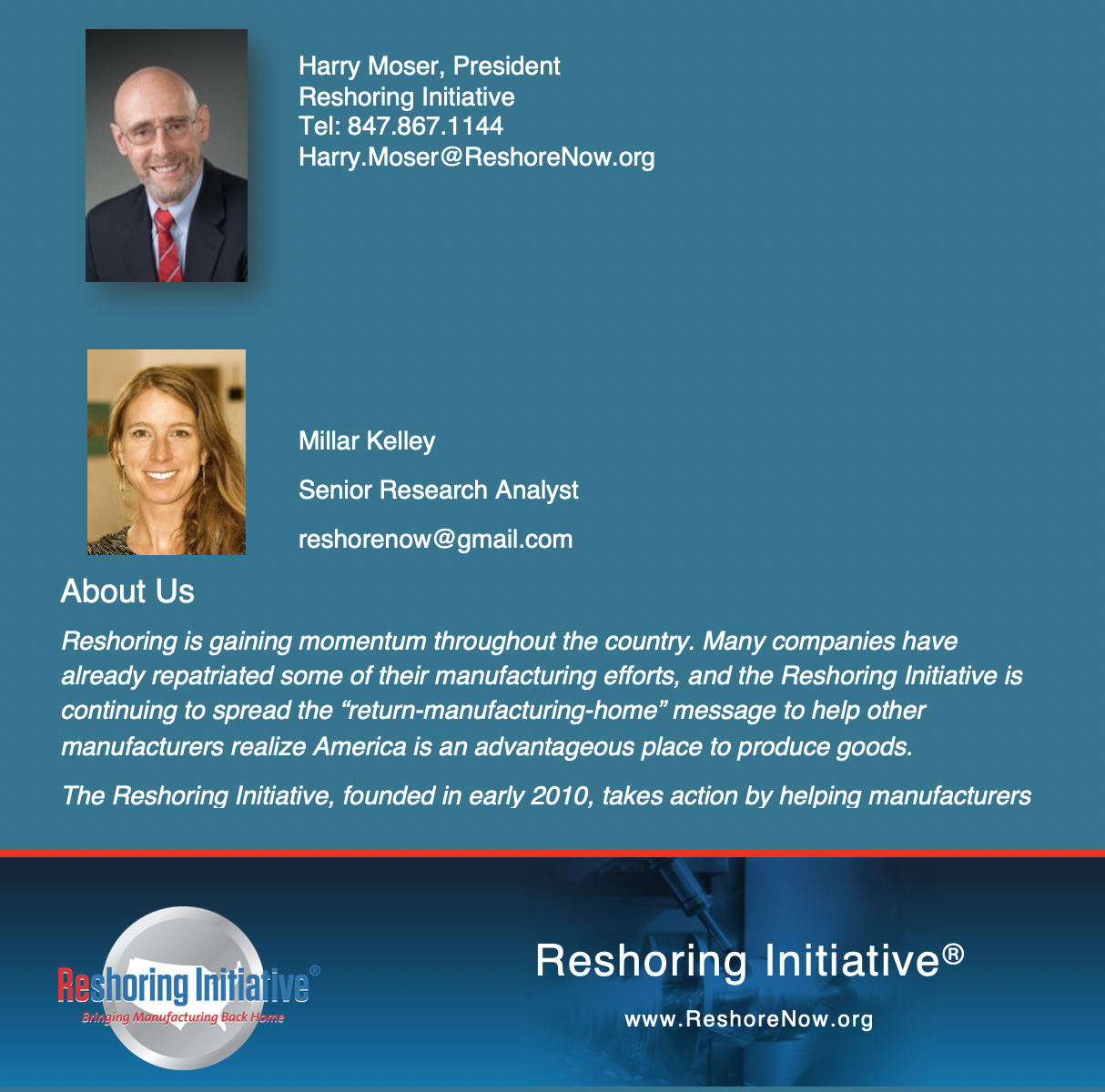RESHORING INITIATIVE® IH2021 DATA REPORT:
RESHORING POISED TO SURGE 38% TO RECORD HIGH

The pandemic has spurred a national push to strengthen the domestic supply chain, especially of essential products, driving reshoring numbers higher. If 2H2021 progresses at the same rate as 1H2021, reshoring and foreign direct investment (FDI) job announcements for 2021 are projected to be over 220,000 – 38% above an excellent 2020 and, by far, the highest yearly number recorded to date.
 The projection of jobs for the essential products that the Biden administration has focused on – chips, EV batteries, PPE, pharmaceuticals, and rare earths - represent 28% (62,500 jobs). Without these products we would be at 157,500. While some of the essential products would have come back without the Biden push (in fact, essential products represented 33% of 2020 jobs with less government push), it is reasonable to state that the administration’s initiatives have driven some but not all of the increase from 2020 (160,000) to 2021 projected (220,000). For the second year in a row, reshoring job announcements outpaced FDI – 62% vs. 38% (historically very high but lower than last year’s rate of 70% reshoring, 30% FDI.) Exhibit 1 The number of companies reporting new reshoring and FDI is also set for a new annual record: 1,800+ companies.
The projection of jobs for the essential products that the Biden administration has focused on – chips, EV batteries, PPE, pharmaceuticals, and rare earths - represent 28% (62,500 jobs). Without these products we would be at 157,500. While some of the essential products would have come back without the Biden push (in fact, essential products represented 33% of 2020 jobs with less government push), it is reasonable to state that the administration’s initiatives have driven some but not all of the increase from 2020 (160,000) to 2021 projected (220,000). For the second year in a row, reshoring job announcements outpaced FDI – 62% vs. 38% (historically very high but lower than last year’s rate of 70% reshoring, 30% FDI.) Exhibit 1 The number of companies reporting new reshoring and FDI is also set for a new annual record: 1,800+ companies.

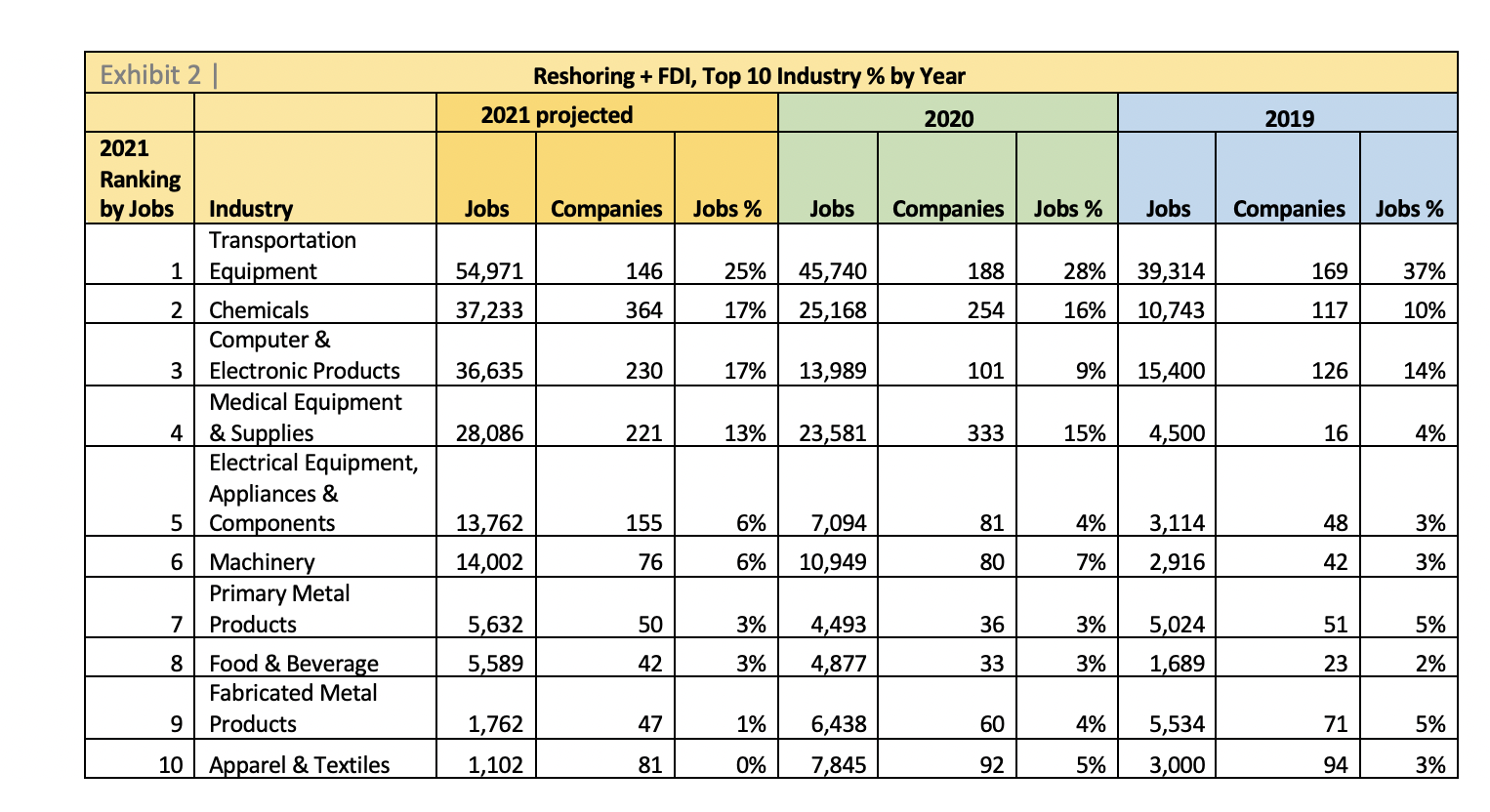
 So far this year Ohio, Arizona and Tennessee have seen the most job announcements. Texas has dropped from 2nd in 2020 to 13th in 2021. South Carolina is 11th after years as #1. Exhibit 4
So far this year Ohio, Arizona and Tennessee have seen the most job announcements. Texas has dropped from 2nd in 2020 to 13th in 2021. South Carolina is 11th after years as #1. Exhibit 4 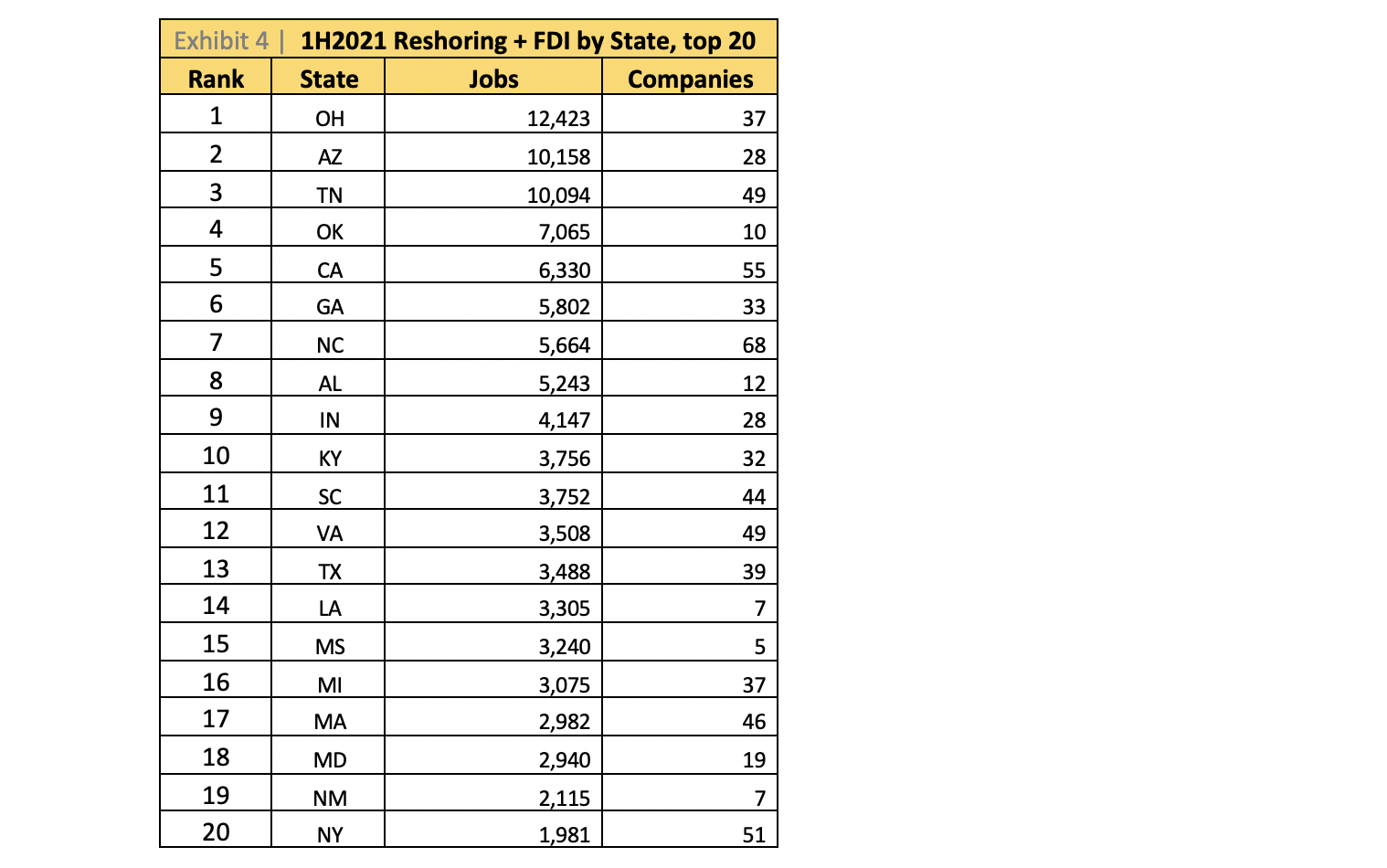 According to the data, currently the most jobs are coming from Korea, predominantly by way of FDI in EV batteries. Exhibit 5 We believe that the rate of jobs coming from China is largely underreported in our data. This is because much of the new essential product production is what we define as “automatic reshoring” - where domestic production is replacing imports in cases where a high percentage of the product has traditionally been imported. In many of these cases, the work is displaced from China, but factory announcements do not report the country whose imports are replaced.
According to the data, currently the most jobs are coming from Korea, predominantly by way of FDI in EV batteries. Exhibit 5 We believe that the rate of jobs coming from China is largely underreported in our data. This is because much of the new essential product production is what we define as “automatic reshoring” - where domestic production is replacing imports in cases where a high percentage of the product has traditionally been imported. In many of these cases, the work is displaced from China, but factory announcements do not report the country whose imports are replaced. 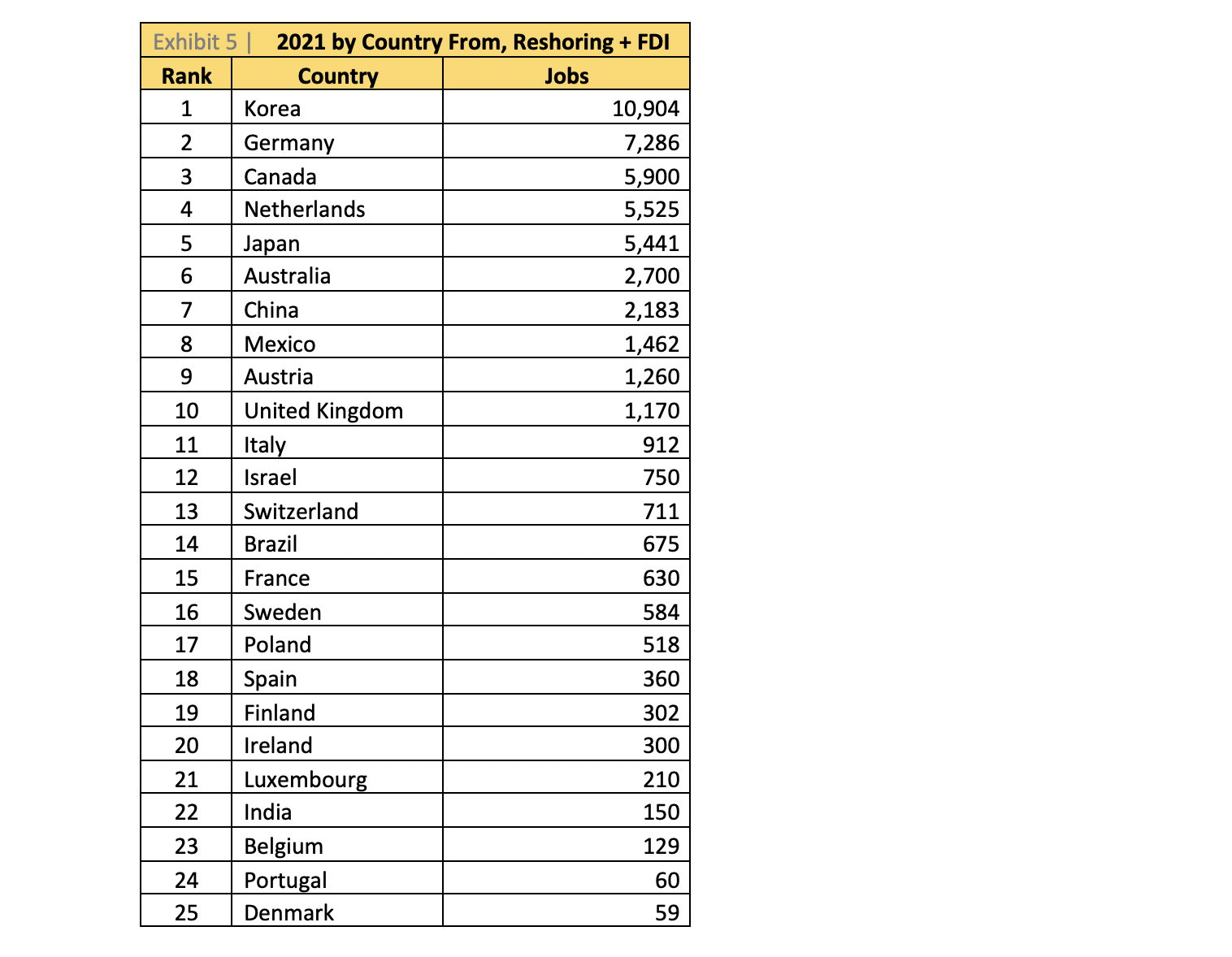
 Reshoring continues to be key to U.S. manufacturing and economic recovery in 2021 and beyond. We see the administration dealing at a superficial level, applying needed tourniquets like investing in chips and EV batteries but not addressing the underlying problem: Our manufacturing costs are about 15% higher than Germany’s and 40% higher than China’s. If we do not address the underlying problems we will not be producing enough electronic products and EVs to absorb our subsidized chips and batteries. We will go from being dependent on Taiwan and China for chips to being dependent on those countries to buy our chips to install in the products we buy from them. Additionally, many countries are investing heavily in chip facilities. When the industry has a global surplus the high cost U.S. chips will not be competitive in the low-cost markets. Here is a link to our analysis of recommended actions. The Reshoring Initiative calls on the Biden administration to solicit our help in developing optimal policies.
Reshoring continues to be key to U.S. manufacturing and economic recovery in 2021 and beyond. We see the administration dealing at a superficial level, applying needed tourniquets like investing in chips and EV batteries but not addressing the underlying problem: Our manufacturing costs are about 15% higher than Germany’s and 40% higher than China’s. If we do not address the underlying problems we will not be producing enough electronic products and EVs to absorb our subsidized chips and batteries. We will go from being dependent on Taiwan and China for chips to being dependent on those countries to buy our chips to install in the products we buy from them. Additionally, many countries are investing heavily in chip facilities. When the industry has a global surplus the high cost U.S. chips will not be competitive in the low-cost markets. Here is a link to our analysis of recommended actions. The Reshoring Initiative calls on the Biden administration to solicit our help in developing optimal policies.
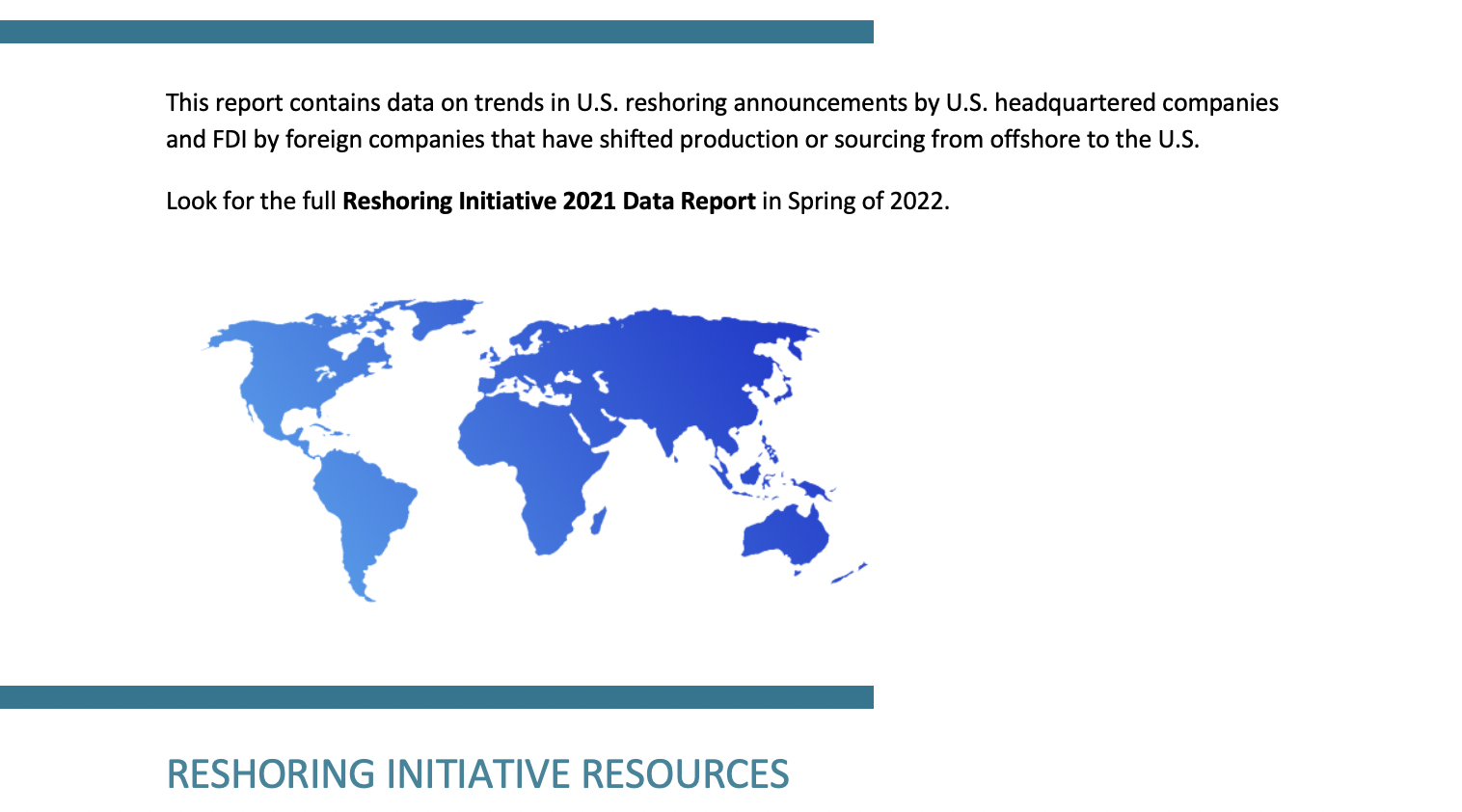
Import Substitution Program (ISP) - Manufacturers select the products at which they excel. ISP identifies and qualifies the major relevant importers of those products. The manufacturers then use TCO to convince the importers to reshore. Offered directly to manufacturers and thru MEPs, EDOs (economic development organizations), trade associations and equipment sellers.
Supply Chain Gap Program - Identifies U.S. supply chain gaps. Helps U.S. manufacturers fill the gaps. Helps EDOs find foreign firms to fill the gaps. Competitiveness Toolkit - Designed to quantify and select the optimal national policy changes to bring back a desired number of jobs. Corporate Social Responsibility Estimator - Provides a model for estimating sourcing decisions’ impact on pollution and on the domestic economy. Reshoring Library – You can use Advanced Search to identify companies that have reshored or done FDI in relevant industries or regions. Search for potential customers.Reshoring Initiative Data Report – Annual reports track the drivers, impact and momentum of the trend.
